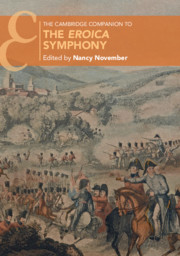Book contents
- The Cambridge Companion to the Eroica Symphony
- Cambridge Companions to Music
- The Cambridge Companion to the Eroica Symphony
- Copyright page
- Contents
- Illustrations
- Musical Examples
- Notes on Contributors
- Eroica Chronology, 1770–2020
- Acknowledgements
- Introduction
- Part I Context and Genesis
- Part II Analytical Approaches
- Part III Reception
- 9 Who is the Hero? The Early Reception of the Eroica
- 10 The Eroica in the Nineteenth and Twentieth Centuries
- 11 Performing, Arranging and Rearranging the Eroica: Then and Now
- 12 The Eroica Endures: Beethoven’s Third Symphony in the Twenty-First Century
- Further Reading
- General Index
11 - Performing, Arranging and Rearranging the Eroica: Then and Now
from Part III - Reception
Published online by Cambridge University Press: 04 June 2020
- The Cambridge Companion to the Eroica Symphony
- Cambridge Companions to Music
- The Cambridge Companion to the Eroica Symphony
- Copyright page
- Contents
- Illustrations
- Musical Examples
- Notes on Contributors
- Eroica Chronology, 1770–2020
- Acknowledgements
- Introduction
- Part I Context and Genesis
- Part II Analytical Approaches
- Part III Reception
- 9 Who is the Hero? The Early Reception of the Eroica
- 10 The Eroica in the Nineteenth and Twentieth Centuries
- 11 Performing, Arranging and Rearranging the Eroica: Then and Now
- 12 The Eroica Endures: Beethoven’s Third Symphony in the Twenty-First Century
- Further Reading
- General Index
Summary
Chamber arrangements of Beethoven’s large-scale works ‘especially his symphonies’ were so prevalent in the nineteenth century that to ignore them is to miss an essential part of the reception or ‘life history’ of the works in question. The depth and dissemination of the arrangements of Beethoven’s works show that these arrangements, rather than the original versions, were an essential means by which Beethoven’s music took effect. In an era when concert performances were still relatively few, an arrangement was often the first instantiation of a Beethoven orchestral work that one would hear. This chapter explores these arrangements as nineteenth-century reception documents, looking at what they tell us not only about Beethoven, but also about the arrangers themselves and the processes of canon formation at the time. The chapter then considers the apparently new ways in which meanings are constructed for the symphony, through performance, and how these relate to Eroica myths and legends born in Beethoven’s day. It discusses ways in which the work has been performed, represented visually, and marketed in the twenty and twenty-first centuries, including the 2003 BBC production, Eroica.
Keywords
- Type
- Chapter
- Information
- The Cambridge Companion to the Eroica Symphony , pp. 221 - 238Publisher: Cambridge University PressPrint publication year: 2020

